Common invertebrate pests
by Melody Kendall
This is the first post of several devoted to discussing garden pests, natural enemies, physical controls and finally pesticide information and uses. There are legions of invertebrate garden pests in the world that can wreak havoc in our landscapes. The garden pest culprits are all those pesky munchers, suckers, borers and slimers. Fortunately, in our area we mostly deal with a ‘dirty dozen' of invertebrate garden pests. This week we will present information on the first six of that "dirty dozen": Aphids, Ants, Imported Cabbage Worms, Codling Moths, Grubs and Scale Insects.

• Almost all plants have some aphid species that will sometimes feed on it.
• They prefer lush new growth so avoid over-fertilizing your plants
• Aphids are actually herbivores. They feed by sucking the plant juices out of the leaves and stems of plants frequently causing the leaves to curl. Interestingly, the juices the aphids drink often have more sugar than protein. So, to access the protein, the aphids drink more of the sugary juices than they need. Because of this they excrete a lot of the excess sugar causing sticky "honeydew." Ants like to drink honeydew and will actually manage populations of aphids by protecting them from predators.
• Low to moderate numbers usually don't damage gardens or landscape trees.
• Aphids can usually just be washed off with a firm stream of water. When pesticides are warranted use the less-toxic products like insecticidal soaps and oils.
• Often removing any ants from the situation will cause the aphid population to decline.
• If aphid numbers are high natural enemies often feed on them.
http://ipm.ucanr.edu/QT/aphidscard.html
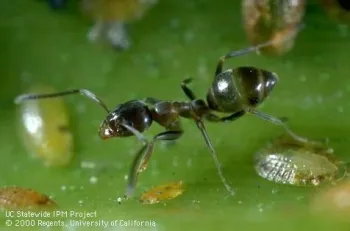
• There are more than 10,000 species of ants in the world.
• Actually ants in the garden are not always a bad thing. They can improve pollination rates when moving from flower to flower in search of food. Ants often help control pests by eating their eggs and young or disturbing them during feeding. When digging their tunnels the ants aerate the soil and help to decompose organic material to fertilize the plants.
• On the down side, ants will protect and increase the numbers of the 'honeydew' producing pests in the garden. Manage ants by removing the 'honeydew' producing insects. Try wrapping a sticky material around the base of affected trees and shrubs to prevent ant access. Ask your nursery about these products.
• Keep leaf litter, mulch, irrigation and foliage away from foundations of buildings where ants are not wanted.
• Use less-toxic pesticide if needed
http://ipm.ucanr.edu/PMG/GARDEN/CONTROLS/antmanagement.html
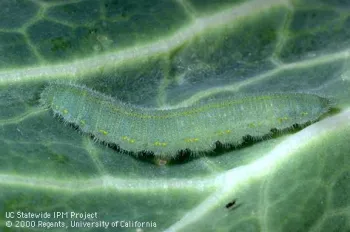
• Native to eastern Europe
• The white adult cabbage butterflies lay eggs singly on leaves and the resulting green, hairy faintly yellow/orange striped larvae grow as they eat your brassica plants and can be up to one inch long. Though slow, the greedy larvae feed on both the inner and outer leaves, often along the rib, leaving fecal pellets behind.
• The cabbageworm is active all year here California.
• Floating row covers can work to help deter the butterflies from laying their eggs.
• Hand picking the larvae, while not for the is very satisfying while you teach them to fly (hopefully not into the neighbor's yard) and/or feed them to the chickens.
• Bacillus thuringiensis or spinosad organic pesticides are very effective.
http://ipm.ucanr.edu/PMG/GARDEN/VEGES/PESTS/importcabwrm.html
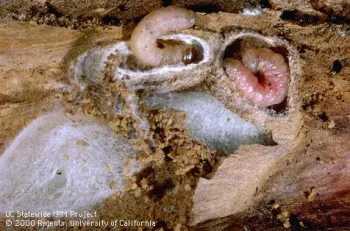
• In California two to four generations can occur per year. Adult moths lay their eggs on fruit and leaves. Hatching larvae immediately bore into fruit leaving a reddish brown trail of frass. Look for reddish brown points of frass on the fruit and removed affected fruit immediately.
• After the larvae overwinter in leaf debris or under the bark of apples, pears or walnuts trees, they pupate in mid-March to April. Destroy raked up fruit that has dropped from the tree.
• Bagging the ½-1 inch fruit four-six weeks after bloom can help curtail the Codling Moth
• Combining the use of low toxic pesticides with non chemical methods is the most sound environmental approach for control. For severe infestations use Cyd-X or spinosad before trying more toxic pesticides. Precisely timed pesticide applications are needed to affect the larvae.
• Early fruiting varieties are less likely to suffer damage from the Codling Moth
http://ipm.ucanr.edu/QT/codlingmothcard.html
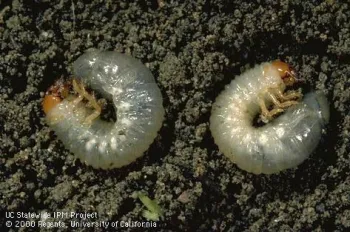
• Grubs are root feeders, and are typically found in lawns but can also be found in garden beds. Grubs found in garden beds are most likely the larval stage of masked chafer beetles. Be careful when amending your beds with home prepared compost as it might contain masked chafer eggs. Before applying compost, be sure it has been properly prepared with sufficient heat to decompose the organic material and to kill insect eggs and other organisms. Hand removal of grubs is easy, and if you have chickens or know someone who does, pass them along. You'll make a friend for life.
• Tiphiid wasps larvae are common parasites of masked chafer beetles, but may not provide effective control.
• Beneficial nematodes can also be used for biological control of grubs.
• As a last resort, neonicotinoid insecticides like imidacloprid can help. Proper timing is essential.
https://www2.ipm.ucanr.edu/agriculture/turfgrass/Masked-Chafers-White-Grubs/
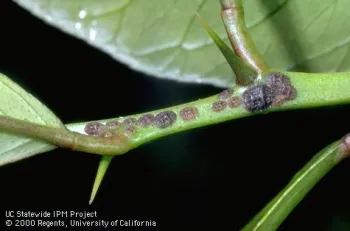
• Young scales are small, slow moving crawlers with legs that drop off when they mature into the immobile adults. Some adult scale appear as elongated circular discolorations resembling raised bark. No obvious head or legs are visible. They are sucking insects that can cause yellowing or dropping of leaves on trees, shrubs and houseplants. Sticky honeydew and sooty mold growing on the honeydew can be the result of a severe soft scale infestation. Control any resident ant access to affected plants. They like the honeydew and will protect the scales from any natural enemies.
• Armored scales are tiny and flat and are usually easy to remove. They do not secrete honeydew.
• Most scales are plant specific. It's up to the gardener whether or not to remove plants that are prone to scale infestations.
• Encourage natural enemies populations
• Applications of horticultural oil during dormant season and when crawlers are active might help to reduce scale numbers
http://ipm.ucanr.edu/PMG/PESTNOTES/pn7408.html
Next week we will finish up our list of the ‘dirty dozen' of invertebrate pests that are all common in our area: snails and slugs, spider mites, thrips, white flies, earwigs, sow bugs and pill bugs. Meanwhile, keep your eyes peeled in your landscape for any of these culprits and take the appropriate action.
Napa Master Gardeners are available to answer garden questions by email: mastergardeners@countyofnapa.org. or phone at 707-253-4143. Volunteers will get back to you after they research answers to your questions.
Visit our website: napamg.ucanr.edu to find answers to all of your horticultural questions.
Photo credits: Jack Kelly Clark
Information Links:
UC Home Site for information on managing pests in the home, garden, turf and landscape: http://ipm.ucanr.edu/PMG/menu.homegarden.html
Pest Notes Library http://ipm.ucanr.edu/PMG/PESTNOTES/index.html
Plant Disease information: UC IPM
Plant diseases: http://ipm.ucanr.edu/PMG/diseases/diseaseslist.html
How to manage pests: http://ipm.ucanr.edu/TOOLS/TURF/PESTS/innem.html
